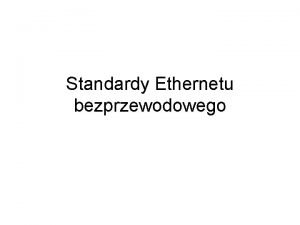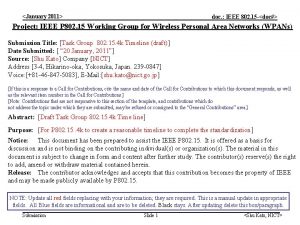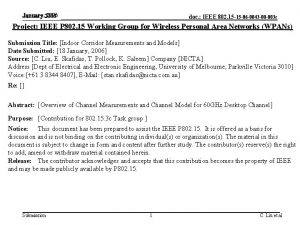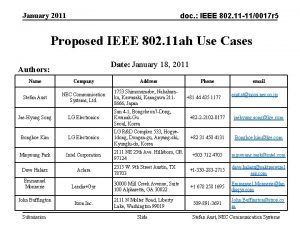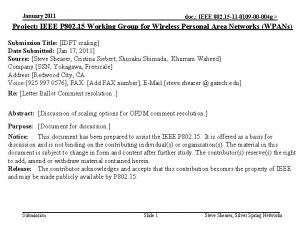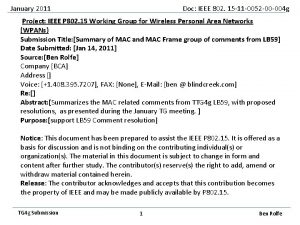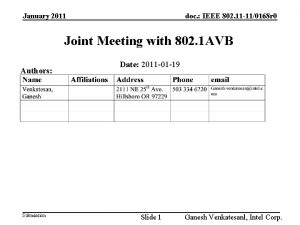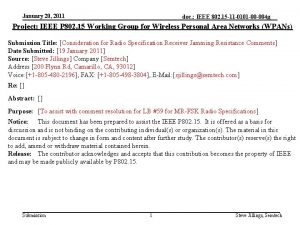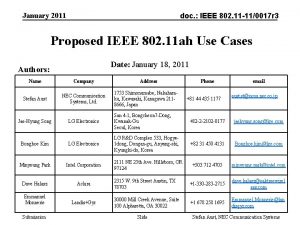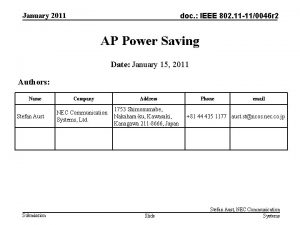January 2011 doc IEEE 802 11 110064 r








![January 2011 doc. : IEEE 802. 11 -11/0064 r 0 Reference • [1] Christian January 2011 doc. : IEEE 802. 11 -11/0064 r 0 Reference • [1] Christian](https://slidetodoc.com/presentation_image_h/7926f9e125a67fc6acba612bb5cac12d/image-9.jpg)


- Slides: 11

January 2011 doc. : IEEE 802. 11 -11/0064 r 0 Modulo Precoding for 11 ac Date: 2011 -01 -17 Authors: Submission Slide 1 Shogo Fujita, Kyushu Inst. Of Tech.

January 2011 doc. : IEEE 802. 11 -11/0064 r 0 Introduction Precoding Techniques for MU-MIMO • Linear precoding - Low complexity, Low data rate (capacity) – Channel Inversion – MMSE Precoding – Block Diagonalization • Non-linear precoding – High Complexity, High data rate (capacity) – Vector Perturbation • Sphere encoding (NP-hard) • Lattice reduction aided (Suboptimal but still full diversity) – Tomlinson Harashima Precoding • Equivalent to a low complexity vector perturbation but the diversity order is the same as Linear Precoding Submission Slide 2 Shogo Fujita, Kyushu Inst. Of Tech.

January 2011 doc. : IEEE 802. 11 -11/0064 r 0 Introduction • The main disadvantage of Linear Precoding is that the normalization constant g (to maintain constant average power) is often very large. • This happens when the transmit vector lies along the singular vectors of the precoding matrix H-1 with high singular value [1]. • Solution Make sure the transmit signal does not lie along the singular vectors associated with large singular value of H-1. Vector Perturbation can provide such transmit signal • This presentation is a proposal for non-linear precoding method like Vector Perturbation. • This technique can minimize the quantity γ Submission Slide 3 Shogo Fujita, Kyushu Inst. Of Tech.

January 2011 doc. : IEEE 802. 11 -11/0064 r 0 Simulation Result • Vector Perturbation : BER Performance (Channel : Rayleigh) Note: Perfect CSI, Ideal Conditions Submission Slide 4 Shogo Fujita, Kyushu Inst. Of Tech.

January 2011 doc. : IEEE 802. 11 -11/0064 r 0 Simulation Result • Vector Perturbation : Signal Power Modulation =64 QAM Channel Model = Rayleigh 4 x [1 1 1 1] MUMIMO case Vector Perturbation can reduce the unnormalized transmit power which increases the effective receive SNR. Submission Slide 5 Shogo Fujita, Kyushu Inst. Of Tech.

January 2011 doc. : IEEE 802. 11 -11/0064 r 0 Vector Perturbation MU-MIMO System Model • VP is analogous to doing MLD in the receiver. • The AP is free to use any algorithm to find the perturbing vector. Complexity can range from a simple O(n) modulo operation to MLD-like complexity • Regardless of the algorithm used by the transmitter, the receiver needs only a predefined modulo lattice operation. STAs doesn’t Manufacturer specific AP User 1 MIMO Decoder modulo User 2 MIMO Decoder VP algorithm modulo need to know how the perturbing vector was generated User k MIMO Decoder modulo User K MIMO Decoder Submission Slide 6 modulo Shogo Fujita, Kyushu Inst. Of Tech.

January 2011 doc. : IEEE 802. 11 -11/0064 r 0 Review-Vector Perturbation • This technique can minimize the quantity γ • Choose l in such a way that x=H-1 has smaller unnormalized transmit power than x=H-1 u Im – τ : positive real value – l : Perturbation vector • each element is composed of a + jb (a and b are integers) • Receiver use modulo operation because a constellation is expanded 0+1 j τ 1+1 j -1+0 j 0+0 j 1+0 j 0 -1 j 1 -1 j τ -1 -1 j n th stream’s decoded symbol : Modulo operation : Submission -1+1 j Slide 7 Re

January 2011 doc. : IEEE 802. 11 -11/0064 r 0 Proposals for TGac • Allow the AP to perform vector perturbation to prevent huge attenuation of transmit signals • Add one bit in the VHT-SIG-A Field to indicate that vector perturbation was performed. – all modulo decode-capable STAs will modulo decode if the bit is set. – The element of l corresponding to modulo decode-incapable STAs can be forced to zero. – Alternatively, the AP will not use VP when one user doesn’t support modulo lattice decoding. Submission Slide 8 Shogo Fujita, Kyushu Inst. Of Tech.
![January 2011 doc IEEE 802 11 110064 r 0 Reference 1 Christian January 2011 doc. : IEEE 802. 11 -11/0064 r 0 Reference • [1] Christian](https://slidetodoc.com/presentation_image_h/7926f9e125a67fc6acba612bb5cac12d/image-9.jpg)
January 2011 doc. : IEEE 802. 11 -11/0064 r 0 Reference • [1] Christian B. Peel, Bertrand M. Hochwald and A. Lee Swindlehurst, “A Vector-Perturbation Technique for Near. Capacity Multiantenna Multiuser Communication -Part II: Perturbation, ” IEEE TRANSACTIONS ON COMMUNICATIONS, VOL. 53, NO. 3, MARCH 2005 Submission Slide 9 Shogo Fujita, Kyushu Inst. Of Tech.

January 2011 doc. : IEEE 802. 11 -11/0064 r 0 Strawpoll #1 • Would you support to allot one bit in the VHT-SIG-A to indicate that modulo lattice decoding is needed after channel equalization? • Yes • No • Abstain Submission Slide 10 Shogo Fujita, Kyushu Inst. Of Tech.

January 2011 doc. : IEEE 802. 11 -11/0064 r 0 Strawpoll #2 • Would you support allowing the AP to have the capability of reducing the signal attenuation by doing vector perturbation ? • Yes • No • Abstain Submission Slide 11 Shogo Fujita, Kyushu Inst. Of Tech.











